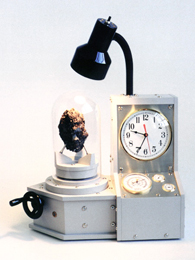What Makes Jon Tick:
Jon's Personal Philosophy
The opposite of art is not science. What few artists seem to realize is that art and science are close cousins, both sharing a creative process that rewards with new discovery and understanding. The distinction between the two is that art is generally concerned with the emotions and beauty, while science is concerned with the workings of the world and also with beauty. Beauty in science is something few artists seem to have considered. The application of science to useful ends is engineering. There is very little distinction between design and engineering. Design is art, as is engineering and science.
Scientific beauty is associated with simplicity. To understand the world is to understand how order flows from chaos, that chaos is another state of order. In truth, the universe is nothing else but order, and science endeavors to understand it and make it useful.
The simplicity of the universe may be difficult for humans to hold in their minds. However, if one discards such an attempt and instead perceives only what is present, the powerful simplicity of the world is strongly felt. This is where art, science, and the experience of consciousness converge.
Order is the state where all things are in their right places. And all places are right. Even that which is ugly, like trash by the highway, can be re framed as something of great beauty. This is not a justification for littering. It is an acknowledgement of the absolute and inescapable beauty of the world.
To be humble is to acknowledge one’s place in the world. The world is gigantic, and the only realistic conclusion is that we are very small. Yet we observe everything from our subjective vantage point. This is the paradox of consciousness. No matter how humble we are before the universe, we experience it from this place only. Our single ego-centric vantage point can be nothing but the most important view we know. In fact, we can know nothing else except in abstraction.
To believe that the world is an illusion placed here for the benefit of our conscious minds, is to invite into ones self a great danger. It is fundamental to human health to reject this notion, for to take it in is to envelop profound isolation and unhappiness and to reject the very perceptions of one’s own body and one’s own existence. In essence it is the annihilation of the self.
It has long been the tenet of science to conceive of and understand the fundamental laws of the universe, the idea being that the universe is made up of only a few fundamental principles that, once their expression in nature is understood, would allow us to comprehend the formation of the universe and its various interactions. This proclaims that behind the wondrous variation we observe there lies an innate simplicity, an innate beauty and harmony. The fundamental tenet of science is to comprehend this beauty. Science is actually devoted to understanding, the revelation of truth, and ultimately to beauty itself.
It could easily be said that the world was created by god, that god is beauty, and the world and the people in it are beautiful and therefor of god, and this would be equally an acceptable understanding as any other. The problem with a religious interpretation lies not in this, but in the desire by some to repress the obvious facts put before our senses. To proclaim that the world with its wealth of geologic history was made 3000 years ago by an act of god, is to disregard the facts of rock formation and fossil record. To believe such a proclamation is to deny the literal evidence before ones eyes.




